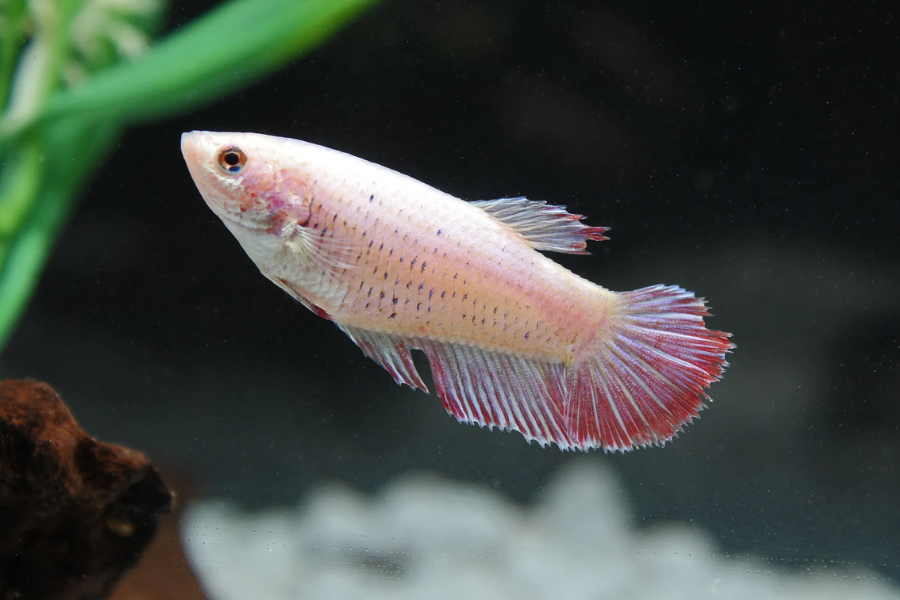When most people think of betta fish, the image that often comes to mind is that of a flamboyant male with flowing fins and aggressive posturing. But behind the curtain of popularity lies a lesser-known gem — the female betta fish. These elegant swimmers may not have the same dramatic fins as their male counterparts, but they carry their own captivating beauty, social dynamics, and low-maintenance charm that makes them ideal for a peaceful community tank.
In this in-depth guide, we’ll explore everything you need to know about the female betta fish, from their radiant coloration to behavior, housing needs, feeding routines, and more. Whether you’re a seasoned aquarist or a curious beginner, learning about female bettas will surely deepen your appreciation for this fascinating species.
Aesthetic Beauty: The Appearance of Female Betta Fish
The visual appeal of the female betta fish is often underappreciated. While they lack the exaggerated, trailing fins of males, female bettas are nothing short of stunning in their own right. These vibrant fish exhibit a remarkable palette of colors, including shades of red, electric blue, emerald green, soft yellows, and even iridescent purples.
Their scales are tightly packed, creating a metallic sheen that shimmers gracefully as they swim. This gives them a gemstone-like appearance under aquarium lighting. Unlike males, female bettas have shorter, rounded fins that promote ease of movement, especially in group environments. Their streamlined bodies and moderate fin length help reduce drag in the water, making them agile and elegant swimmers.Over time and with proper care, the colors of a female betta fish often become even more vibrant, a true sign of health and happiness in their environment.
Understanding Female Betta Fish Behavior
Unlike males, which are notoriously territorial and solitary, female betta fish are more socially inclined and can cohabit peacefully with one another when given the right setup. This opens up exciting possibilities for aquarists looking to keep a sorority tank — a group of female bettas living harmoniously.
Female bettas are curious by nature. They often explore every inch of their tank, rest on broad-leaf plants, and interact with one another in subtle ways. Occasionally, you may see them flaring their gills or nipping gently at each other, which is a way to establish a pecking order. These behaviors, while sometimes mistaken for aggression, are part of their natural social structure.
Stress-related behaviors such as fin flaring usually subside once dominance is established and the environment remains calm. Given plenty of space and hiding spots, female betta fish will often settle into peaceful coexistence, showcasing their personalities through gentle dances, synchronized swimming, and playful chases.
Ideal Habitat: Housing Requirements for Female Betta Fish
Creating the perfect environment for female betta fish is crucial to their wellbeing. While a single female can thrive in a small 5-gallon tank, a group of three to five females (often referred to as a betta sorority) will need a tank of at least 20 to 30 gallons.
Key Setup Essentials:
- Tank Size: Minimum of 20 gallons for a small sorority
- Filtration: Gentle filter to avoid strong currents, which can stress bettas
- Heater: Maintain a stable water temperature between 78°F and 80°F (25.5°C–26.5°C)
- Decorations: Use silk plants, live plants, and smooth hiding caves or betta logs to provide cover and reduce visual stress
- Substrate: Sand or soft gravel to shield fragile fins from harm.
- Lighting: Use a light/dark cycle to simulate natural lighting conditions.
Having a well-designed tank ensures that each female betta fish can claim a personal territory, hide when needed, and feel secure in the group dynamic. Avoid overcrowding, as this increases stress and may lead to conflict.
Balanced Nutrition: Feeding and Diet Tips for Female Bettas
Nutrition plays a pivotal role in maintaining the health, color, and vitality of your female betta fish. While they have smaller appetites compared to males (due to lower territorial activity), they still need a varied and protein-rich diet to flourish.
Feeding Guidelines:
- Primary Diet: High-quality betta pellets or flakes formulated specifically for bettas
- Additional Foods: Provide frozen or freeze-dried snacks such as brine shrimp, daphnia and bloodworms two to three times a week.
- Feeding Schedule: Twice per day, offering only what they can consume in 2–3 minutes
- Fasting: Once a week, give them a day without food to help regulate their digestive system
- Portion Control: Avoid overfeeding, as uneaten food will cloud the water and cause ammonia spikes
A nutritious diet ensures that the female betta fish develop brilliant colors and maintain optimal energy levels without becoming obese — a common issue in captive fish.
Routine Tank Maintenance: Clean Water, Happy Fish
Maintaining clean, well-filtered water is essential for the health of your female betta fish, especially in a group setting. Female bettas are generally more tolerant of each other, but poor water conditions can quickly lead to stress, disease, and heightened aggression.
Recommended Maintenance Schedule:
- Water Changes: Replace 25–30% of the tank water once or twice weekly
- Filter Cleaning: Rinse the filter media in old tank water (not tap) during water changes to preserve beneficial bacteria
- Gravel Vacuuming: Remove debris and uneaten food from the substrate weekly
- Water Testing: Use test kits to monitor ammonia, nitrite, nitrate, and pH levels regularly
Proper tank hygiene helps preserve the delicate ecosystem that supports the wellbeing of female betta fish, allowing them to remain colorful, interactive, and disease-free.
Social Dynamics: Building a Peaceful Betta Sorority
Observation, preparation, and the proper conditions are necessary for the successful formation of a female betta fish group. Introduce all females to the tank at the same time to reduce territorial disputes. Monitor them closely during the first few days for excessive aggression or bullying.
Tips for Harmony:
- Choose similarly sized females to prevent dominance struggles
- Rearrange decorations before introducing new members to disrupt established territories
- Have multiple hiding places to allow shy individuals to retreat
- Observe feeding to ensure all fish are eating and not being bullied away from food
Though some squabbling may occur, well-managed sororities can offer a fascinating glimpse into the natural social order of female betta fish.
Why Female Betta Fish Make Great Pets
The female betta fish is an ideal choice for aquarists seeking a pet that is both visually striking and emotionally rewarding. With the right conditions, they display a captivating combination of intelligence, curiosity, and social grace.
Here are some reasons why female bettas stand out:
- They add vivid colors and gentle movement to your aquarium
- They exhibit unique personalities and group behavior
- They’re relatively low-maintenance and hardy
- They can live in a community setup unlike males
Their lively presence and manageable care routine make them perfect for hobbyists who want more interaction and diversity in their tanks.
FAQs:
Q1: What tank size is best for a group of female betta fish?
A 20 to 30-gallon tank is ideal for housing a group of 3–5 female betta fish. This gives them enough space to establish territories and swim comfortably without clashing.
Q2: Are female bettas aggressive like males?
Not typically. While female betta fish can be territorial, they are generally more tolerant of each other. Minor flaring and chasing can happen but usually settle once a hierarchy is established.
Q3: How often should I clean the tank?
Partial water changes of 25–30% should be done once or twice weekly to maintain healthy water parameters and keep the female betta fish in top condition.
Q4: Can I mix female bettas with other fish species?
Yes, in many cases. Peaceful tank mates such as neon tetras, corydoras, and snails can coexist with female betta fish. Avoid fin-nippers and aggressive species.
Q5: What signs show a female betta is stressed or sick?
Watch for faded colors, clamped fins, loss of appetite, hiding excessively, or erratic swimming. These signs may indicate stress, poor water quality, or illness.
Conclusion:
Often overshadowed by the flamboyant male, the female betta fish is a hidden treasure in the world of aquarium keeping. With their jewel-like scales, graceful movements, and intriguing group dynamics, they bring both beauty and life to any home tank.
By understanding their needs — from space and food to social structure and maintenance — you can ensure your female betta fish thrive and flourish. They’re not just “less colorful males.” They are radiant individuals with their own charm, deserving of the spotlight in any aquatic setup.Whether you’re starting a sorority tank or simply exploring new additions for your aquarium, consider the vibrant, intelligent, and personable female betta fish. You might just find they become your favorite aquatic companions.
Stay in touch to get more updates & news on Hoseasons!

